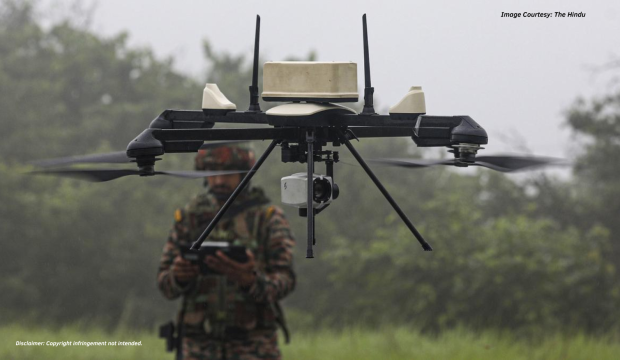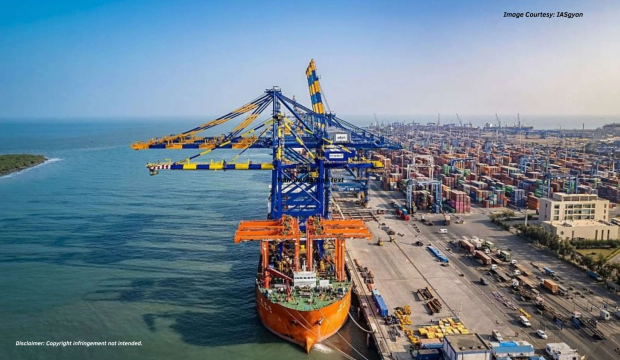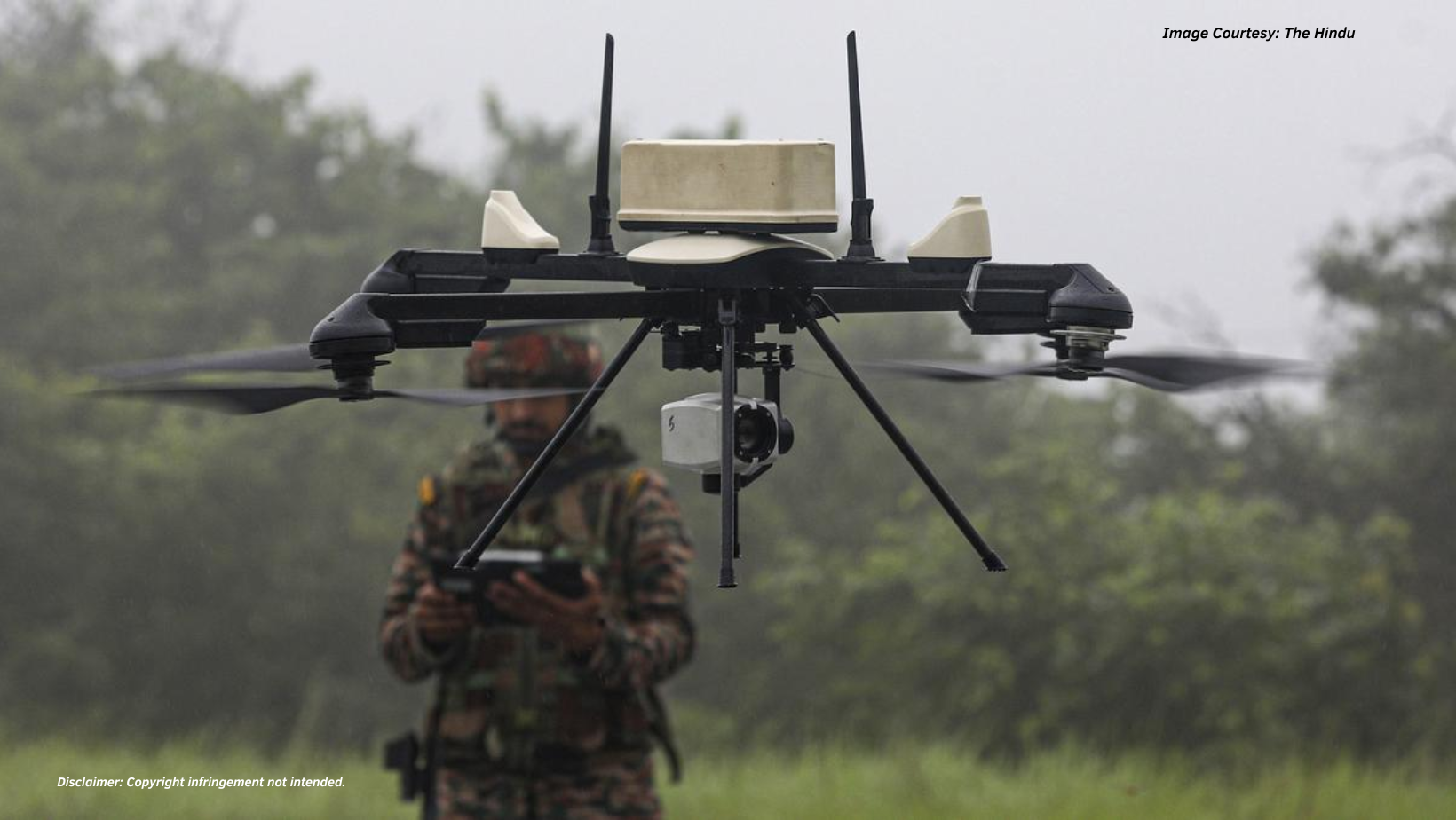Introduction
The Indian region of Jammu and Kashmir has always been a hotbed of terrorism, this is multifaceted and finds its roots in the social, political, religious, economic and geographical composition of that area. While the presence of these issues in the region has prevailed over time, their trends and frequency have been evolving. Terrorism by nature is dynamic and constantly evolves in tune with the situation. The newly declared Union Territory comprises approx.3.6% of India’s land and is naturally divided into six valleys [1] (CRS Reports 2019). Another important geographical division is the one between North Kashmir and Jammu divided by the Pir Panjal mountains. The focus of researchers who study terrorism in the region has changed over the years in terms of the geographical region under fire. This has largely remained dominant in the Kashmir Valley, with a few trends of uptake in the region South of the Kashmir Valley.
Terrorism in South Kashmir and Jammu: An Upsurge in Violence
Kashmir valley has been the hotbed of terrorism in the region since independence, while South Kashmir and Jammu have been comparatively peaceful and violence-free, especially for the last two decades. Ever since the Rashtriya Rifles and the local police drove the terrorists out of the region lying to the South of Pir Panjal in the 1990s, the region has been devoid of major terrorist attacks or tensions. However, this has changed recently, especially with the rampant attacks and targeted killings – in the Poonch and Rajouri regions, signalling an upsurge in violence. This uptick can be observed since 2015 with the beginning of targeted Hindu killings being carried out in the region and can be said to have established itself in 2019 with the Pulwama attack of 2019 which claimed the lives of 40 CRPF men and was labelled as the most dastardly attack in the region since the 1990s [2] (The Crisis Group 2022). This recent upsurge lays the ground for insightful analysis with a prime focus on the trends of terrorism brewing in the region and its roots in the multifaceted environment of the Union Territory along with a comparison from the historical trends as well as those witnessed in the North.
The Pir Panjal Region: A Breeding Ground for Terrorism
This belt has been relatively peaceful with a period of turmoil in the early 1990s which was contained by 1996 and has been subdued ever since. The Geography of the region along with an influx of social, economic and political; factors has fueled the recent uptick in terrorism.
Influence of Geographical Proximity to Conflict Zones
Before proceeding ahead, it is important to understand the region and its geographical location, which is the prime focus of this analysis. The Pir Panjal is the large mountainous stretch that separates the Kashmir valley and the area of South Kashmir and Jammu. Rajouri and Poonch are two such districts of Jammu which are separated by the range from the rest of the valley. This region is important for a lot of reasons- firstly because of the historic belief on both sides that control over Pir Panjal means control over the entire valley. Secondly, because of the region’s proximity to the border with Pakistan and the number of passes and infiltration routes that exist here[3] (Ahmad 2022). While most of these are inaccessible in the Winter, they can be easily used to cross the borders in the Summer. At many locations, local citizens and acclimatized troops make the crossing through the high passes in much less than an afternoon. The Pir Panjal region is predominantly forest land which makes it difficult for the security forces to track and apprehend the terrorists after terror attacks and incidents, and it makes it easier for them to to escape and go into hiding. This has largely remained a challenge for the counter-terrorism forces in this region. What makes the scenario more worrisome is that the woodland area, wherein the terrorists hide and find shelter, extends up to Shopian in South Kashmir. The infiltrating terrorists are believed to be using this route to reach South Kashmir.

Source: Frontline, The Hindu
Socio-Economic and Political Factors
The factors that have led to this recent upsurge need to be carefully examined to determine the motivations and the reasons for the renewed upsurge of terrorism in the region. The upsurge has been in place since the 2015 announcement of the central government which called for the rehabilitation of Kashmiri Pandits back in the region and to creation of 3,000 jobs as well as the establishment of townships for them[4] (Majid 2023). This has been believed to have aggravated the terrorist groups who used this as a pretext to entice the locals This can also be linked to the targeted killings of Hindus in the region. This, coupled with the 05 Aug 2019 revocation of the special status of Jammu and Kashmir, provided the perfect trigger for the terrorists to exploit the circumstances and sympathise with the locals and youth in the region, and to radicalise them. The removal of status also meant that outsiders could now own land in the region which created a sense of apprehension amongst the locals that the government wanted to change the demographic of the Muslim-majority areas.
A J&K Police official also said that Pakistan-based jihadi terrorists are frustrated at the overpowering response and public enthusiasm witnessed during Home Minister Amit Shah’s public rally in Muslim-dominated Rajouri on October 4, 2022[5] (Puri 2021). Shah had, while addressing the rally, alluded to the inclusion of the Pahari community in the Scheduled Tribes (STs) list, at par with Gujjar and Bakarwal communities, which did not resonate with these communities, despite assurances from the Government. The delimitation Commission has reserved six of the nine Assembly segments in the Pir Panjal Valley for STs.
Poverty and unemployment have also given an upward push to terrorism within the area. Especially, the lack of economic opportunities and improvement has left many young people feeling disenfranchised and at risk of extremist propaganda and narrative. The image created by the author, as provided below shows the socio-economic challenges in the region as established via NITI Aayog report of 2021[6] (NITI Aayog 2021).

The Changing Dynamics
On every occasion where India is slated to host large global activities, a terrorist-related incident in J&K has been in the making. This has been so repetitive that there may be a level of cynicism attached to it. The most notable instance of this trend was the Chittisinghpura bloodbath of March 2000 in sync with President Bill Clinton’s speech to the Parliament. The April 2023 incident which resulted in the brutal killing of five soldiers was likely to derail the arrangements for a G-20 occasion which was scheduled to be held in J&K’s capital Srinagar on May 22-23 and additionally, the visit of Pakistan’s Foreign Minister Bilawal Bhutto to Goa on 05 May 2023 to attend the Shanghai Cooperation Organization Summit [7] (Nagial 2023). The correlation between the upsurge in attacks and the two summits may be attributed to Pakistan’s efforts to disrupt the events, and discredit India’s policies and handling the situation in J&K.
Pakistan and China have already been making attempts to disrupt India’s Presidency of the two summits and have been discouraging member states from attending the conference. The successful conduct of the G20 Tourism Assembly in Kashmir from 22-24 May 2023, regardless of Pakistan’s attempts to derail it, gives a lie to the malicious and baseless information war by Pakistan.
Shift in Tactics and Strategies, Radicalisation- Terrorists
In recent years, there has been a shift in the tactics and strategies of terrorists within the South Kashmir and Jammu area. The emergence of homegrown terrorists and the recruitment of disaffected and vulnerable youth has driven the localization and indigenization of terror in the region.
There is a new category of Hybrid Terrorists who are carrying out these attacks and killings, they are civilians with no prior links to terrorist groups who go back to their everyday lives post the attack. This has made it difficult for the forces to identify and apprehend them. Local youth has largely been the target of this radicalisation, which has limited involvement of foreign terrorists [8] (Shah 2020).
Terrorist outfits, with great sophistication, have modified the character of their social media propaganda. In previous terrorism stages, social media propaganda was largely disorganized and decentralized. Terrorist recruits now frequently share pictures of themselves after becoming a member of the ranks while claiming assaults. Nicely crafted, professionally produced films and photos are regularly published on Telegram channels. However, their circulation is centralized and anonymized to ensure continuity and shield terrorists.
Post 2019, especially after the revocation, terrorism has been largely home-based with little to no external support. This has been witnessed with the larger absence of JeM and LeT and the emergence of new groups like ULKF, TRF and PAFF which have localities as participants.
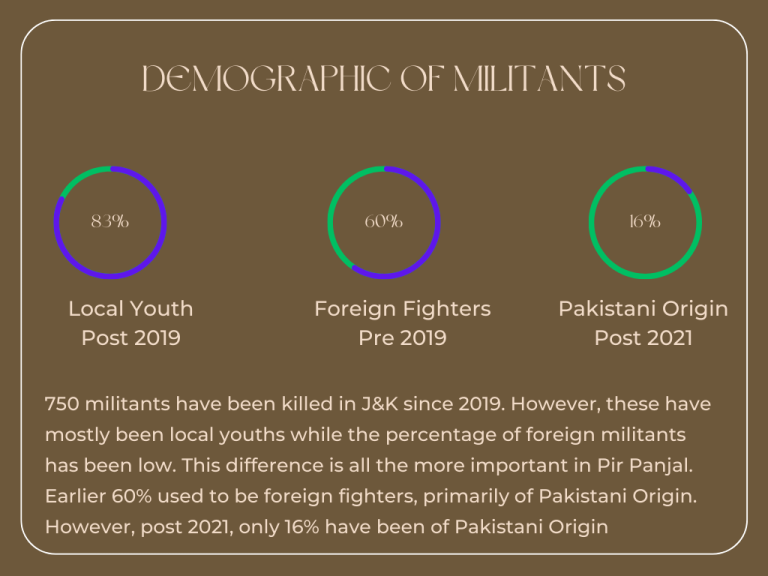
The author has created the image. Information is taken from: (Ahmad 2022), (Zargar 2023)
Extant Counter-terrorism Strategy
When terrorism had an upsurge in the 1990s, it was driven away by active collaboration between the police and the Rashtriya Rifles (RR). The capabilities of police stations were enhanced and made stronger as they were provided with appropriate training and weaponry to drive out terrorism. RR has been the primary anti-terrorism force in the region. However, in a political decision to show change and peace in the region, its drawdown and eventual complete replacement with CRPF forces have been deliberated post the 2019 administrative changes to the region. There has been a redeployment of elements of RR to the Ladakh region instead to handle the stand-off and escalated military tensions along the LAC with China in Ladakh (after Chinese intrusions in April-May 2020) and the terrorists seem to have exploited this opportunity. It is important to note the higher vulnerability of CAPF (Central Armed Police Forces) in such a region due to higher age profiles and the difficult terrain of the region.
Historically, every time the army’s presence was reduced in terrorism-affected areas, the terrorist stranglehold would increase in the ensuing months. This happened in 2012 too, while units from South Kashmir were redeployed to plug the gaps inside the counter-infiltration grid. It resulted in the voids being refilled by terrorist presence, bolstered with the introduction of OGW networks. In response to the recent attacks in April and May 2023, the redeployment and drawdown plans have been put on hold indefinitely but the fear is that the damage might already have been done.
Contrasting North and South Kashmir: Understanding Regional Differences
North Kashmir, which includes Baramulla, Kupwara, and Handwara, has been less violent than the Southern part of the valley recently. In line with data from the Ministry of Home Affairs, there had been 32 terrorist incidents in North Kashmir in 2020, compared to 74 in South Kashmir [9] (Zargar 2023). There have also been notable differences in the character of terrorist activities of the North and South.
The composition and geographical differences also play an important role here. The dense forest region of Pir Panjal and the largely hilly terrains of Poonch and Rajouri are ideal for guerrilla tactics used by the terrorists. Another point of difference is the demographic composition of South Kashmir, where the population is largely similar to that of POK in terms of culture, language and ethnicity. Poonch has a 90% Muslim population while Rajouri stands at 60%[10] (CRS Reports 2019). These similarities deepen the ties between the locals here and those in POK. The cultural similarities and lifestyle habits also mean that it is easier for foreign terrorists to blend in with the local population, making the task of security forces all the more difficult. The counter-terrorism strategies are also more difficult to develop here as this region has a comparatively less developed surface transport connectivity than the valley.
Another point of difference is the use of drones in this region by the terrorists which have been spotted frequently near Pir Panjal but not so much in Northern Kashmir. Drones have been regularly noticed in the air space of the Jammu plains that border Pakistan’s Sialkot district.
Implications for National Security & Response
The government’s decision to reduce RR inside the South Kashmir region has had mixed consequences, with recruitment into terrorist cells reducing in a few regions but remaining an issue in others. The recent terrorist attacks and incidents in the Pir Panjal region have made it clear that a strong military presence remains a sine-qua-non. The implications of the decision are uncertain at present, and it remains to be seen how the government will respond to the situation in the region. It is important for the authorities to cautiously remember the potential outcomes of any changes within the region.
Addressing the Upsurge: Strategies and Countermeasures
The recent upsurge has led to a revival of the Counter Terrorism forces in J and K. As many as 18 fresh agencies of the CRPF, comprising about 1,800 personnel have been deployed in the areas of Rajouri and Poonch. The administration has also moved to revive the Village Defence Guard which comprises civilians and was disbanded in the past after the terrorism died down in the 1990s. There are already 5,000 armed members inside the district, and greater numbers of villagers are registering to get trained with arms. Earlier the members were provided with a 303 rifle and a hundred rounds of ammunition [11] (Puri 2021). Now the government is also planning to equip them with SLR rifles. Deliberate cordon and search operations are also being carried out in the region, however, they have not yet been successful due to the geography and hence there is a need to resort to effective human and technical intelligence-gathering approaches.
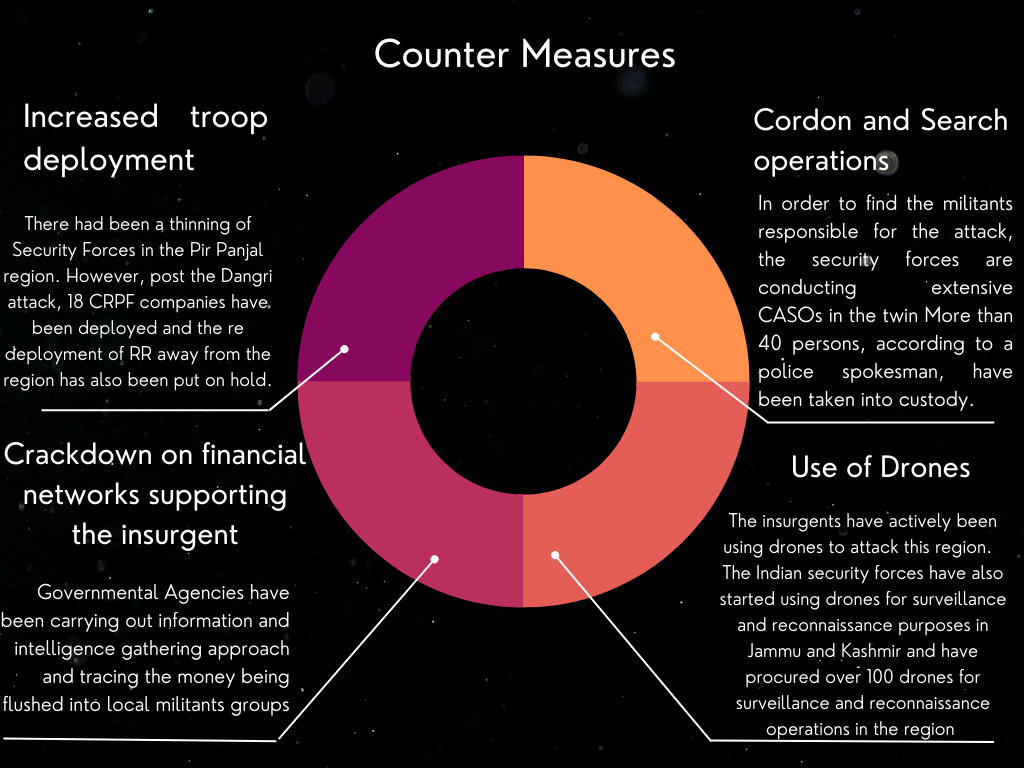
The author has created the image
Whole Nation/Govt Approach-Governance, Community Engagement and Trust-Building Initiatives
To cope with the upsurge of safety challenges, a whole-of-nation/government method is essential. Governance, community engagement, and trust-building initiatives are crucial in this regard. The Indian authorities have been taking steps to cope with the problem of security[12] (Puri 2021). The counter-terrorism strategy in the Kashmir Valley has been a success, and the situation has improved appreciably.
Community engagement is another vital factor in addressing safety situations. The government should interact with communities in regions that may be facing protection challenges, to build trust, and deal with the root causes of grievances. This can consist of financial opportunities, addressing discrimination, and making sure that the rule of law is upheld.
The authorities have to address the root causes of the problem, such as poverty, unemployment, and lack of established schooling education systems. The youth in the region need to be provided with higher possibilities and avenues. Most essentially, addressing the underlying problems will thwart the upsurge of terrorism and radicalization in the South Kashmir and Jammu region.
Conclusion
The motives of the terrorist groups are clear, they wish to stretch the capabilities of the armed forces by creating disturbances in the South Kashmir region as the military is already stretched thin between LAC and LOC. The recent changes in the footprints of RR have provided them with the perfect opportunity to carry it out. While the geopolitical dynamics point towards Pakistan’s involvement, its links to the upsurge at present are not quite apparent, as it is largely home-based with few foreign elements or fighters involved. Since it is an issue of radicalised youth, the government strategies to deal with the issue need to be all the more focused to ensure that it does not alienate them further. Hence, even the village force needs to be re-evaluated, since if it is predominantly a Hindu force, it might lead to further alienation of the Muslim population and its associated allegations of Human Rights abuses, as in the past.
DISCLAIMER
The paper is author’s individual scholastic articulation and does not necessarily reflect the views of CENJOWS. The author certifies that the article is original in content, unpublished and it has not been submitted for publication/ web upload elsewhere and that the facts and figures quoted are duly referenced, as needed and are believed to be correct.
References
[1] CRS Reports. 2019. “Kashmir: Background, Recent Developments, and U.S. Policy,” CRS Reports.
[2] The Crisis Group. 2022. “Violence in Kashmir: Why a Spike in Killings Signals an Ominous New Trend.” Crisis Group.
[3]Ahmad, Manzoor. 2022. “Emerging Contours of Security in Jammu and Kashmir | Manohar Parrikar Institute for Defence Studies and Analyses.” IDSA
[4] Majid, Zulfikar. 2023. “Pak trying to revive militancy in Muslim-dominated Rajouri-Poonch?” Deccan Herald.
[5] Puri, Luv. 2021. “South of Pir Panjal poses counter-terror challenges.” Tribune India.
[6]“NITI Aayog MPI Report.” 2021. NITI AAYOG. 2021.
[7] Nagial, Balwan S. 2023. “Terrorist attack in Poonch.” Times of India.
[8] Shah, Khalid. 2020. “Ideological shift, public support and social media: The ‘New’ in Kashmir’s ‘New Militancy.’” ORF.
[9] Zargar, Safwat. 2023. “What government data says – and doesn’t – about militancy in J&K since the scrapping of Article 370.” Scroll
[10]CRS Reports. 2019. “Kashmir: Background, Recent Developments, and U.S. Policy,” CRS Reports.
[11] Puri, Luv. 2021. “South of Pir Panjal poses counter-terror challenges.” Tribune India.
[12] Puri, Luv. 2021. “South of Pir Panjal poses counter-terror challenges.” Tribune India.




